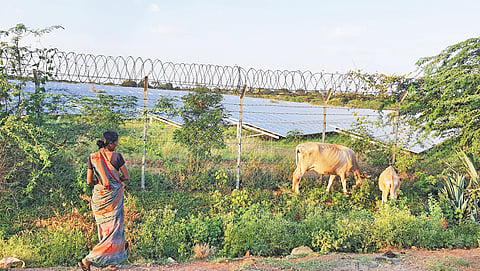

In Karnataka’s drought-prone Chitradurga district, the sun now illuminates two sharply contrasting futures. For large landowners, solar parks that have mushroomed across many villages have meant lease cheques, cars and freedom from farming’s uncertainties. For smallholders, landless labourers and pastoralists, however, the same gleaming panels have brought displacement, vanishing livelihoods and deepening precarity.
“Farming has always been a gamble. Only when rain, labour and prices aligned could we make any income,” says Soma Shekhar Reddy, a groundnut farmer from Bedareddyhalli village, who also raised silkworms on his 15 hectares (ha). Today, his fields lie behind fences, covered by solar panels spread across 101 ha. In 2016, he leased his land to a private company under a 28-year contract worth Rs 17 lakh a year, with payments increased by 10 per cent every five years. In neighbouring Vaddikere village, Tippeswamy B V, who owns 8 ha, is still waiting for such an opportunity. “For the last 20 years, I have farmed only 2-2.4 ha. The rest has turned into wasteland,” he says. “There is no profit. If a solar company comes tomorrow, I will lease it all,” he says.
This desperation has turned drought-hit regions into prime locations for solar projects. “All these projects are coming up in places where human development indicators such as maternal and infant mortality or education levels remain poor,” says Bhargavi Rao, a researcher who has studied solar parks in Karnataka. Instead of investing in long-promised irrigation facilities, politicians are pushing solar projects. In India, solar and wind park development is exempt from environmental and social impact assessments under the 2006 Environment Impact Assessment Notification, which mandates such assessments under the Environment (Protection) Act, 1986.
The brunt of this is being paid by small farmers like ...
This article was originally published in the September 1-15, 2025 print edition of Down To Earth